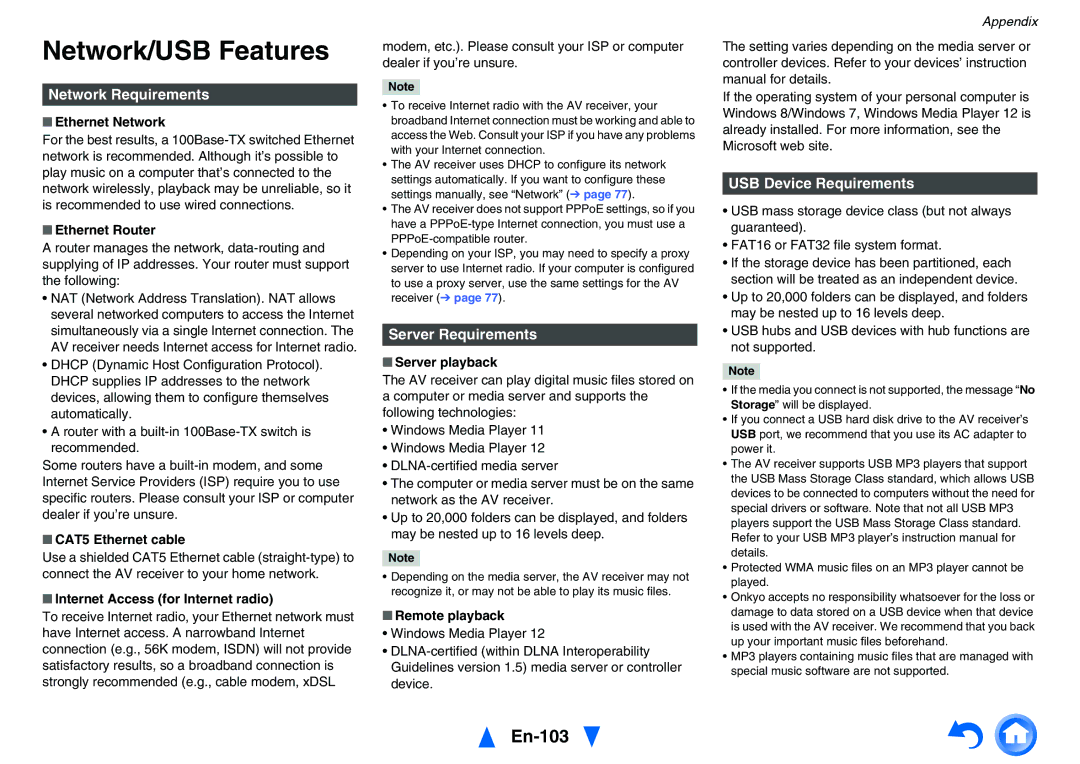
Network/USB Features
Network Requirements
■Ethernet Network
For the best results, a
■Ethernet Router
A router manages the network,
•NAT (Network Address Translation). NAT allows several networked computers to access the Internet simultaneously via a single Internet connection. The AV receiver needs Internet access for Internet radio.
•DHCP (Dynamic Host Configuration Protocol). DHCP supplies IP addresses to the network devices, allowing them to configure themselves automatically.
•A router with a
Some routers have a
■CAT5 Ethernet cable
Use a shielded CAT5 Ethernet cable
■Internet Access (for Internet radio)
To receive Internet radio, your Ethernet network must have Internet access. A narrowband Internet connection (e.g., 56K modem, ISDN) will not provide satisfactory results, so a broadband connection is strongly recommended (e.g., cable modem, xDSL
modem, etc.). Please consult your ISP or computer dealer if you’re unsure.
Note
•To receive Internet radio with the AV receiver, your broadband Internet connection must be working and able to access the Web. Consult your ISP if you have any problems with your Internet connection.
•The AV receiver uses DHCP to configure its network settings automatically. If you want to configure these settings manually, see “Network” (➔ page 77).
•The AV receiver does not support PPPoE settings, so if you have a
•Depending on your ISP, you may need to specify a proxy server to use Internet radio. If your computer is configured to use a proxy server, use the same settings for the AV receiver (➔ page 77).
Server Requirements
■Server playback
The AV receiver can play digital music files stored on a computer or media server and supports the following technologies:
•Windows Media Player 11
•Windows Media Player 12
•
•The computer or media server must be on the same network as the AV receiver.
•Up to 20,000 folders can be displayed, and folders may be nested up to 16 levels deep.
Note
•Depending on the media server, the AV receiver may not recognize it, or may not be able to play its music files.
■Remote playback
•Windows Media Player 12
•
En-103
Appendix
The setting varies depending on the media server or controller devices. Refer to your devices’ instruction manual for details.
If the operating system of your personal computer is Windows 8/Windows 7, Windows Media Player 12 is already installed. For more information, see the Microsoft web site.
USB Device Requirements
•USB mass storage device class (but not always guaranteed).
•FAT16 or FAT32 file system format.
•If the storage device has been partitioned, each section will be treated as an independent device.
•Up to 20,000 folders can be displayed, and folders may be nested up to 16 levels deep.
•USB hubs and USB devices with hub functions are not supported.
Note
•If the media you connect is not supported, the message “No Storage” will be displayed.
•If you connect a USB hard disk drive to the AV receiver’s USB port, we recommend that you use its AC adapter to power it.
•The AV receiver supports USB MP3 players that support the USB Mass Storage Class standard, which allows USB devices to be connected to computers without the need for special drivers or software. Note that not all USB MP3 players support the USB Mass Storage Class standard. Refer to your USB MP3 player’s instruction manual for details.
•Protected WMA music files on an MP3 player cannot be played.
•Onkyo accepts no responsibility whatsoever for the loss or damage to data stored on a USB device when that device is used with the AV receiver. We recommend that you back up your important music files beforehand.
•MP3 players containing music files that are managed with special music software are not supported.
